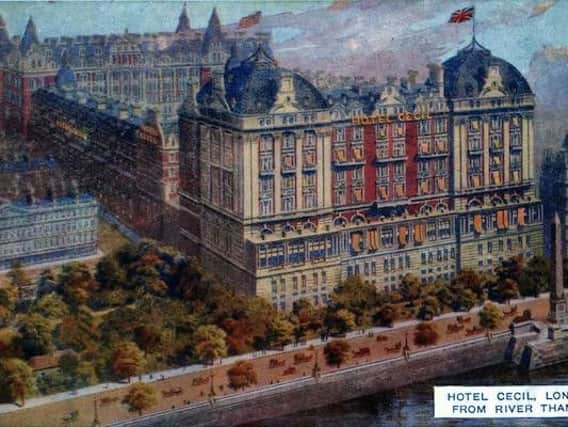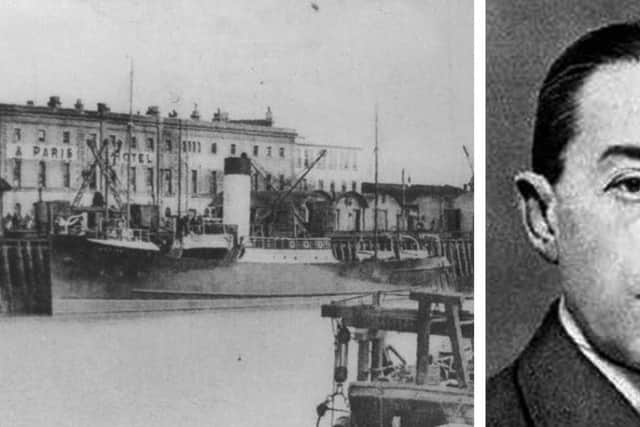Was '˜Ace of Spies' Reilly mixed up in murky Newhaven murder?


Reilly - the legendary “Ace of Spies” - was certainly a larger than life character who is suspected of undertaking espionage for at least three other major powers as well as Britain.
I say “suspected” because the details of the life of Reilly are shrouded in mystery and many episodes must be taken with a large pinch of salt.
Advertisement
Hide AdAdvertisement
Hide AdFor certain though he has a sinister link to a death in Sussex that occurred in 1898.


Reilly’s real name was Sigmund Rosenblum. Born in the Black Sea port of Odessa in 1873, he came to England and by 1896 was living in London running his Ozone Preparations Company, an enterprise purveying ”miracle cure” medicines.
Rosenblum was a brilliant linguist and this gift is what brought him to the attention of William Melville, head of Scotland Yard’s Special Branch who recruited him as a paid informant for the émigré intelligence department.
His “quack” medicine business was a convenient front for an erstwhile spy but he did have real customers. One of these was a gullible Reverend Hugh Thomas who suffered a persistent kidney ailment. He had a young and pretty wife, Margaret, whom Rosenblum found attractive. Soon the pair embarked on an affair.
Advertisement
Hide AdAdvertisement
Hide AdOn 4th March 1898, Thomas made Margaret the executor of his will. The next week the churchman and his nurse checked into the London & Paris Hotel in Newhaven.


The Newhaven - Dieppe ferry docked close by but Thomas may have gone there simply for the fresh sea air, perhaps on the advice of Rosenblum.
On 12th March 1898 the Reverend Thomas was found dead in his hotel room. Dr. T. W. Andrew attended the body and certified that the cause of death was influenza and stated that there was no need for an inquest. Thomas’s nurse accepted the doctor’s verdict. In later years, researchers could find no record of a doctor named T. W. Andrew practicing anywhere in England in 1898.
Upon learning of her husband’s death, Margaret insisted he be buried immediately. There was no police investigation even when it was revealed that the nurse (hired by Margaret) once had an employer who died of arsenic poisoning.
Advertisement
Hide AdAdvertisement
Hide AdMargaret inherited £800,000. In August 1898 she married Rosenblum. Two government officials - one of them associated with Scotland Yard’s William Melville – witnessed the ceremony. Rosenblum had by then changed his name to Sidney George Reilly – his new surname copying Margaret’s maiden name. In June 1899 the couple travelled to St. Petersburg ostensibly as tourists but actually so that Reilly could glean information about Czarist Russia for the British government. His spying career had begun in earnest.
There is a worrying postscript to the death of the Reverend Thomas. On 25th October 1908 an employee of the Hotel Cecil in London’s Strand disappeared without trace. Louisa Lewis had worked at the Cecil since 1904. Previous to that she had worked at the London & Paris Hotel in Newhaven where her father was the manager.
On 13th March 1898 Louisa would have witnessed the timely arrival of the mysterious Dr. Andrew, who had examined the body of Thomas and pronounced his death to be from natural causes.
Louisa was last seen in the Cecil in the early evening conversing with a dark-haired gentleman at the foot of the hotel’s main staircase. He could have been anyone. But compelling circumstantial factors point to him being Sidney George Reilly.
Advertisement
Hide AdAdvertisement
Hide AdIn 1898 Reilly’s Ozone Preparation Company was based at 97 Fleet Street, not far from the Cecil. Reilly often stayed in the Cecil, at the time the biggest hotel in Europe. Might Louisa have recognized Reilly as being the Dr T.W. Andrew she’d encountered in Newhaven in 1898? A check of the hotel register would have confused her what with Reilly’s name being there instead of that of the doctor. Perhaps she even challenged the guest as to his real identity?
If this had indeed occurred, Reilly could simply have said she was mistaken. After all, Thomas’s death had been put down to natural causes with not the slightest official hint of foul play. Even so, given Reilly being a master of machinations and intrigue, he might well have decided that the girl must be silenced. He was necessarily ruthless - he once accepted a mission to assassinate Bolshevik leader Lenin.
We’ll never know what happened to poor Louisa Lewis from Newhaven. But we know what happened to Reilly who, incidentally, split with wife Margaret and had several more marriages, at least one of which was bigamous. His spying took him all over the world and he was variously in South Africa, Manchuria’s Port Arthur (where he spied for the British and Japanese), China, Germany, France and Scandinavia.
It was in Russia where he’d been drawn time and again on missions that his luck ran out.
Advertisement
Hide AdAdvertisement
Hide AdIn September 1925 he crossed the Finnish border believing he would be meeting men from an anti-Bolshevik movement.
It was a trap and Reilly was captured by the Russians and taken to Moscow’s notorious Lubyanka Prison.
After five weeks of brutal interrogation and apparently on Stalin’s direct order, he was taken out to a forest and executed by firing squad.